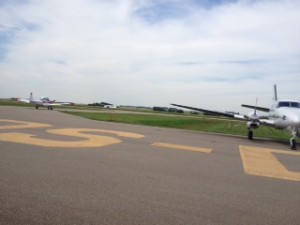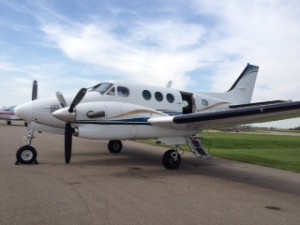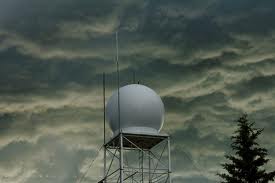Summer is just around the corner and there are whispers that 2016 is supposed to be a “bad” hail year. Given all of the hot dry weather we have had so far, it wouldn’t be surprising to see some severe thunderstorms in the weeks ahead.
We thought it would be helpful to re-post some information on hail suppression and the details of our visit out to the Olds-Disbury Airport in the summer of 2014.
The hailstorm suppression tour was put on by Dr. Terry Krauss of the Alberta Severe Weather Management Society. The tour started with a slide show presentation explaining why there is such a huge need for cloud seeding in Alberta, and how the overall process works. Following the slide show, we met with the meteorologists who monitor the weather and track storms and they explained how the radar and tracking system works and about what their responsibilities are. We then had the opportunity to view and hop on board one of the five aircraft they use for cloud seeding.
Following the severe and disastrous September 7, 1991 Calgary hailstorm, the insurance industry began looking at ways to reduce losses caused by hail damage. Hail suppression programs operate successfully in numerous countries around the world, and it was decided that this was the type of program Alberta needed. A private non-profit organization, The Alberta Severe Weather Management Society, was established by Insurance Companies to administer the cloud seeding program. The cloud seeding operations are contracted to Weather Modification Canada Ltd.
Cloud seeding is done with flares with the intent to create MORE hail. Here is a brief explanation of how it all works:
- Thunderstorms are seeded with billions of silver iodide smoke particles (given off by flares).
- The particles act as artificial ice crystals to freeze up the super-cooled water drops in the storm’s updraft.
- This causes the storm to produce a greater amount of small pebble-sized hailstones as opposed to a lesser amount of large, damaging hailstones.
The hail suppression project began in 1996 and operates yearly from June 15th to September 15th. Hailstorms are seeded as they develop along the foothills, and the current seeding territory runs from High River north to Rocky Mountain House, Bentley and Lacombe. The seeding aircraft, which are equipped with wing flares as well as flares in the belly of the plane, follow the stronger storms as they move off the foothills and towards populated areas. Priority is assigned to storms depending upon two factors: their severity, and the size of the community they are threatening. The hailstorms and cloud seeding aircraft are continuously tracked by radar and satellite.
There are no adverse environmental effects from cloud seeding, as the silver iodide salt is not a toxic or hazardous material. The amount of silver iodide used is very small relative to the large quantities of water in the storms. As well, silver occurs naturally in Canadian soil and many foods, as well as in very low concentrations in our water supply. Hail and water samples have been collected from seeded storms to test the levels of silver, which were found to be similar to those found in surface and tap water.
Overall, cloud seeding has assisted Insurance Companies in reducing losses caused by hailstorms. As such, this test program has continued past the 5 year testing phase and is now in its 20th year!
For more information about cloud seeding and other weather and environment related programs, please visit the Weather Modification Incorporated website.
Thank you,
The Costen & Associates Team








